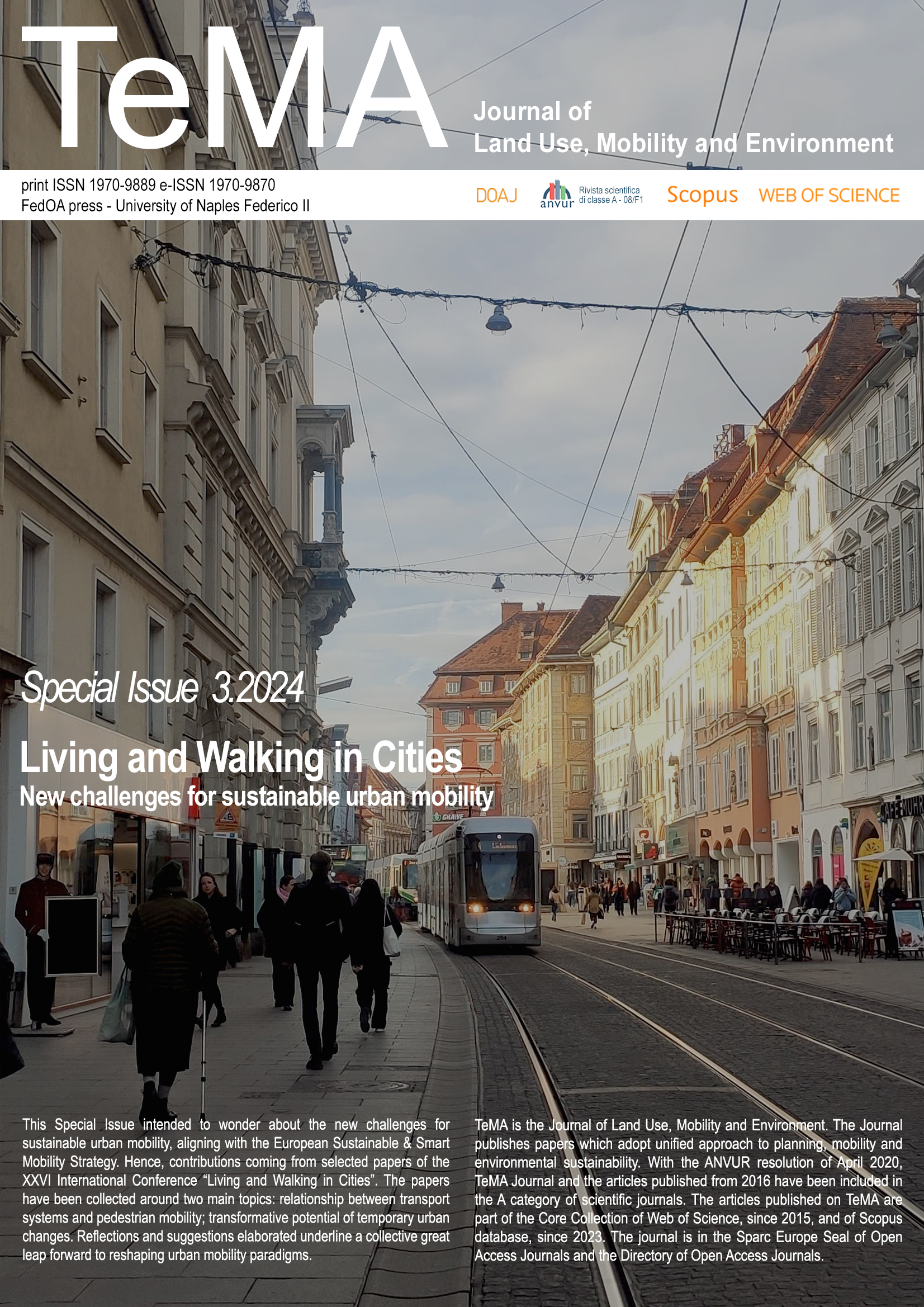Permanently temporary. Street experiments in the Torino Mobility Lab project
Abstract
Street experiments introduce changes in the use, regulation or form of streets with the aim of triggering systemic shifts in urban mobility from motorized traffic to active travel and more livable public space. Generally intended to be temporary at implementation, street experiments may be repeated over time or even become permanent, depending on their success. This paper analyses four experimental road reallocation interventions that were implemented in August/December 2020 in the Italian city of Turin, as part of the Torino Mobility Lab project. These pedestrianizations were implemented in a temporary, experimental and low-cost way for four months, during which a monitoring activity was launched in order 1) to measure the use and the perception of the value of these temporary pedestrianizations in order to decide whether or not to make them permanent, and 2) to collect data on the ways they were used, as well as suggestions from their users for the design of the permanent versions of those that would have been confirmed. The paper analyses this monitoring/evaluation process and identifies some barriers and factors that can complicate and slow down the transition from temporary to permanent street reallocation.
Downloads
References
Abdelfattah, L., Deponte, D. & Fossa, G. (2022). The 15-minute city: Interpreting the model to bring out urban resiliencies. Transportation Research Procedia, 60, 330–337. https://doi.org/10.1016/j.trpro.2021.12.043
ATI - Agenzia per lo sviluppo locale di San Salvario Onlus, Laqup, Solco Onlus, Urban Lab Torino (2020). Servizio di accompagnamento al progetto Torino Mobility Lab. Allegati. Retrieved from: https://torinomobilitylab.it/wp-content/uploads/2021/02/Allegati-1-2-3_TorinoMobilityLab_Repor_ATI.pdf (accessed 1.3.23)
Bertolini, L. (2020). From “streets for traffic” to “streets for people”: Can street experiments transform urban mobility? Transport Reviews, 40 (6), 734–753. https://doi.org/10.1080/01441647.2020.1761907
Bocca, A. (2024). Sustainable development and proximity city. The environmental role of new public spaces. TeMA - Journal of Land Use, Mobility and Environment, 17 (1), 71-87. https://doi.org/10.6093/1970-9870/10414
Bragaglia, F., & Caruso, N. (2020). Temporary uses: A new form of inclusive urban regeneration or a tool for neoliberal policy? Urban Research & Practice, 0(0), 1–21. https://doi.org/10.1080/17535069.2020.1775284
Brand, C., Dons, E., Anaya-Boig, E., Avila-Palencia, I., Clark, A., de Nazelle, A., Gascon, M., Gaupp-Berghausen, M., Gerike, R., Götschi, T., Iacorossi, F., Kahlmeier, S., Laeremans, M., Nieuwenhuijsen, M. J., Pablo Orjuela, J., Racioppi, F., Raser, E., Rojas-Rueda, D., Standaert, A., … Int Panis, L. (2021). The climate change mitigation effects of daily active travel in cities. Transportation Research Part D: Transport and Environment, 93, 102764. https://doi.org/10.1016/j.trd.2021.102764
Campisi, T., Basbas, S., Tesoriere, G., Canale, A., Vaitsis, P., Zeglis, D. & Andronis, C. (2020). Evaluation of Pedestrians’ Behavior and Walking Infrastructure Based on Simulation. In Computational Science and Its Applications – ICCSA 2020 (741–753), Springer International Publishing. https://doi.org/10.1007/978-3-030-58802-1_53
D’Amico, A. (2023). Urban spaces and pedestrian mobility: the role of urban design for enhancing walkability. TeMA - Journal of Land Use, Mobility and Environment, 16 (3), 639-644. https://doi.org/10.6093/1970-9870/10327
Davis, A. (2020). School Street Closures and Traffic Displacement Project: A Literature Review with semi-structured interviews. Transport Research Institute, Edinburgh Napier University
EMTA – European Metropolitan Transport Authorities (2021). EMTA Barometer 2021. Retrieved from: https://www.emta.com/IMG/pdf/211007-barometeremta-2019.pdf
Gehl, J. & Svarre, B. (2013). How To Study Public Life. Washington DC Island Press/Center for Resource Economics. https://doi.org/10.5822/978-1-61091-525-0
Gössling, S., Schröder, M., Späth, P. & Freytag, T. (2016). Urban Space Distribution and Sustainable Transport. Transport Reviews, 36, 659–679, 2016. https://doi.org/10.1080/01441647.2016.1147101
Lahoorpoor, B., Wu, H., Rayaprolu, H. & Levinson, D. (2022). Prioritizing active transport network investment using locational accessibility. TeMA - Journal of Land Use, Mobility and Environment, 15 (2), 179-192. https://doi.org/10.6093/1970-9870/9174
Mehta, V. & Bosson, J. K. (2021). Revisiting Lively Streets: Social Interactions in Public Space. Journal of Planning Education and Research, 41(2), 160–172. https://doi.org/10.1177/0739456X18781453
Norton, P. (2015). Of love affairs and other stories. In Incomplete streets. Processes, practices, and possibilities (pp. 17–35). London & New York: Routledge
Sadik-Khan, J. & Solomonow, S. (2017). Streetfight: Handbook for an urban revolution. Penguin: New York.
Verlinghieri, E., Vitale Brovarone, E. & Staricco, L. (2023). The conflictual governance of street experiments, between austerity and post-politics. Urban Studies, 61 (5), 878-899. https://doi.org/10.1177/00420980231193860
Vitale Brovarone, E., Staricco, L. & Verlinghieri, E. (2023). Whose is this street? Actors and conflicts in the governance of pedestrianisation processes. Journal of Transport Geography, 107, 103528. https://doi.org/10.1016/j.jtrangeo.2022.103528
von Schönfeld, K. C. & Bertolini, L. (2017). Urban streets: Epitomes of planning challenges and opportunities at the interface of public space and mobility. Cities, 68, 48–55. https://doi.org/10.1016/j.cities.2017.04.012
Copyright (c) 2024 TeMA - Journal of Land Use, Mobility and Environment

This work is licensed under a Creative Commons Attribution 4.0 International License.
Authors who publish in this journal agree to the following:
1. Authors retain the rights to their work and give in to the journal the right of first publication of the work simultaneously licensed under a Creative Commons License - Attribution that allows others to share the work indicating the authorship and the initial publication in this journal.
2. Authors can adhere to other agreements of non-exclusive license for the distribution of the published version of the work (ex. To deposit it in an institutional repository or to publish it in a monography), provided to indicate that the document was first published in this journal.
3. Authors can distribute their work online (ex. In institutional repositories or in their website) prior to and during the submission process, as it can lead to productive exchanges and it can increase the quotations of the published work (See The Effect of Open Access)

